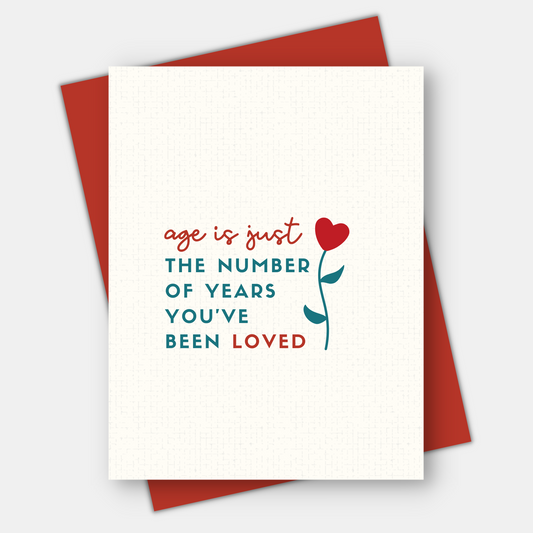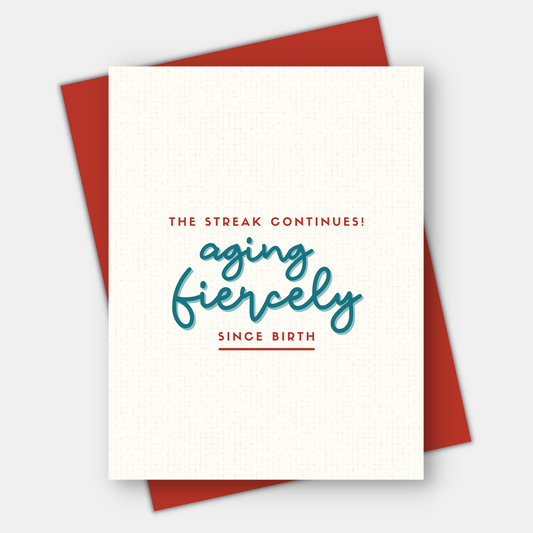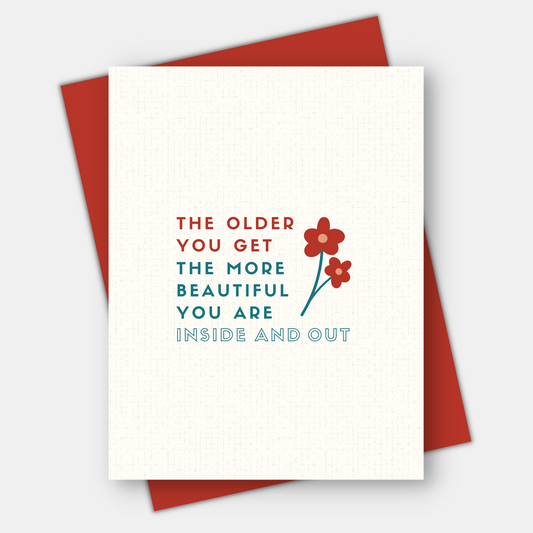I found where it all started—the birth of the snarky, ageist birthday card.
You know, the type of card with a cartoon caricature of a bent-over, crabby old lady, with a sharp wit and bitter attitude. The one that contributes to the ageist messages that over 82% of people over 50 claim to see every day.
It started at Hallmark™, a 2.6 billion-dollar company that has made a lot of money tapping into the psyche of American culture and, as a result, has influenced millions of people. And in some cases, in a not-so-positive way.
The Birth of Maxine
Shoebox Greetings, the “tiny little division of Hallmark,” was created in 1986 as an alternative to sappy, sentimental cards you would send when you “care enough to send the very best.”
For this new, edgy division of Hallmark™, a 25-year old cartoonist named John Wagner presented his version of an ‘old lady’ that reminded him of his mother, grandmother, and unmarried Aunt.
Her name? Maxine.

John was attempting to capture the snarky comments he heard from these older women in his life. Putting their thoughts and actions to life through Maxine, and her dog, Floyd.
Maxine slings insults on everyday annoyances, including men, bad drivers, long lines, and her favorite subject, getting older.
“Maxine taps into what we all think and feel but don’t say because we’re too nice. Through her, we can make those caustic remarks we really want to,” said Hallmark’s marketing director in an interview in 1997.
My mother was right there with them. She didn’t give a rat’s ass what anyone thought of her. She was also living in a time when days were spent cooking, cleaning, and raising children. Bitterness came out in the form of a sharp tongue.
When Maxine first emerged on card racks in the fall of 1986, she was an instant hit with consumers sick of sappy sentimentality and many other things going on in their lives.
80’s and 90’s Culture
I’m guessing John’s mother and Aunt would have been 50-60 years old when Maxine was created in 1986. John is my age, born in 1961, at the tail end of the baby boomer generation.
The ’80s were a time when Ronald Reagan was president, Oprah Winfrey debuted, and the Space Shuttle Challenger exploded. Popular TV shows included The Golden Girls, The Cosby Show, and Married with Children.
I was working 9 to 5 (as in the famous movie), building a career in a male-dominated field while raising kids, and figuring out how long I could last in a lousy marriage.
During this period of conservative politics, women watched as the Equal Rights Amendment was overturned, putting equality, women’s rights, and reproductive rights back in jeopardy.
Maxine tapped into a generation of women struggling to find power, and more importantly, their voice. That voice came out in the form of a sharp-witted, sarcastic cartoon character.
Maxine was an acceptable way to get in jabs about the frustration of life since, after all, Hallmark™ created her. Giving a sarcastic card to your girlfriend with a clever quip about the disappointment of the day was something new and novel and wildly popular.
During this period, it also became fashionable to insult your loved one on their birthday. A seed planted so deep it’s still growing decades later.
Not Everyone Was Laughing
As Maxine was tapping into the social frustrations of the time, her favorite topic was taking jabs at getting older.
Maxine firmly planted the seeds of ageism with comments like,
- You look so young for an old person.
- There’s an old saying about how great it is to get older. Too bad I can’t remember what it is.
- Another birthday. Do you see wrinkles? Do you see gray hair? Of course, you don’t. Your eyesight is gone.
- And many more comments about how awful it is to be old.

Maxine had the staff at Hallmark™ concerned. A spokeswoman for the company noted that they were worried that people might be offended when Maxine first came out.
In a 2018 interview, Chris Brethwaite, a lead writer for Maxine, who is now catching up with Maxine in age, said, "I used to sit at my desk and snicker at some of the things I came up with age-wise," he said, chuckling. "They're not so funny anymore.”
By 1997, on an 11 year run with Maxine, over 160 million Maxine cards were sold. The creator of Maxine was stunned, declaring in an interview that, “I had no idea what I was creating.”
When John was asked if he would send a Maxine card to his mother on her birthday, “No,” he says, laughing. “I send nice cards to my mother.”
Maxine Today
Even though John retired in 2011, Maxine lives on! After all, in the 7.5 billion dollar greeting card industry, it’s hard to let go of a legend.
But is Maxine still slinging ageist messages? Hell yes!
Taking a look at the 26 Maxine cards for sale on the Hallmark website in June of 2021,14 of them have direct ageist messages. Imagine a line of greeting cards that were overtly racist, sexist, or homophobic. They would never make it on the shelf in retailers.
No doubt, the Maxine character represents the birth of the ageist birthday card. She single-handedly made it fashionable to offend your loved one on their birthday. Walk down the greeting card aisle, and her influence is undeniable.

Even if you think some of what Maxine says is clever, you fuel ageism when you buy a Maxine-style card.
On the back of Maxine cards sold today, they add clever sayings to get you thinking. One of those sayings is, “People tell us they love Maxine because she says what they're thinking. It makes us wonder about people.”
In addition to wondering about the people buying these cards, I wonder about the people creating ageist cards and the people responsible for putting them on the shelf.
I wonder if they realize their contribution to our youth-obsessed culture, the multi-billion dollar anti-aging product business, and most devastating, the decrease of life-span by 7.5 years who internalize ageism.
It’s time to stop ageism and rethink how we think about aging.




